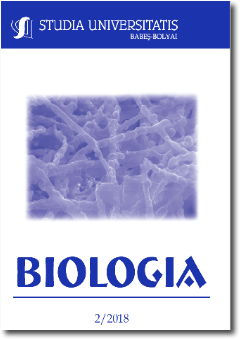Treatment of rubber effluent from rubber processing plant with fungi
DOI:
https://doi.org/10.24193/subbbiol.2018.2.08Keywords:
effluent, industry, indigenous, rubber.Abstract
Rubber processing industry produces materials used for the manufacturing of rubber industrial products. Large volume of water is consumed and produces a huge amount of effluent which is later discharged into the waterways, thereby causing pollution that affects human health. The effluent was collected from discharge points of a rubber factory. Microbial analyses were carried out before and after pollution. During the incubation, microbial growth in culture tubes was determined using UV-Spectrophotometer by measuring absorbance at wavelength 600nm at 24 hours interval. Four fungi were isolated and identified from rubber effluents which include Mucor mucedo and Aspergillus niger, Aspergillus flavus and Penicillium notatum. Individually, the selected fungi isolates were tested for its efficiency on the bioremediation of rubber processing effluent. The physicochemical properties reduction of the effluent such as BOD, COD, TS, TSS, TDS, phosphate and ammonia were observed after incubating for 7 days. Based on the data obtained in this study, it can be concluded that Mucor mucedo and Aspergillus niger can be used for bioremediation of rubber processing industry effluent with high efficiency.
References
APHA (1995) Standard method for the examination of water and wastewater, 19th ed. American Water Work Association and Water Environment Federation, Washington D.C.
Arun, A., Uma Maheshwari, P., Thillai, K. (2004) Biodegradation of tannery effluent by using tannery effluent isolate. In: Arvind Kumar (ed) Environmental contamination and bioreclamation. APH Publishing Co., New Delhi, pp. 451-453
Asia, I. O., Akporhonor, E. E. (2007) Characterization and physicochemical treatment of wastewater from rubber processing factory. Int. J. Phys. Sci., 2: 61 – 67
Atagana, H. I., Ejechi, B. O., Ayilumo, A. M. (1999a) Fungi associated with degradation of wastes from rubber processing industry. Environ. Model. Assess., 55: 401–408
Atagana, H. I., Ejechi, B. O., Ogodu, M. I. (1999b) Bacteria associated with degradation of wastes from rubber processing industry. Env. Mon. Assess., 59: 145-154
Barnett, H. L., Hunter, B. B. (1987) Illustrated genera of imperfect fungi. New York, Macmillan Publishing Company. pp. 122–179
Bode, H. B., Kerkhoff, K., Jendrossek, D. (2001) Bacterial degradation of natural and synthetic rubber. Biomacromol., 2: 295 – 303
Cheesebrough, M. (2000) District Laboratory Practice in Tropical Countries, part II (Microbiology). Cambridgeshire Tropical Health Technology, Cambridge, United Kingdom. 231p.
Cherian, E., Jayachandran, K. (2009) Microbial degradation of natural rubber latex by a novel species of Bacillus sp. SBS25 isolated from soil. Int. J. Env. Res., 3: 599 – 604
Cowan, S. T., Steele, K. J., (1974) Manual for Identification of Medical Bacteria. 2nd. Ed., Cambridge University Press, Cambridge, United Kingdom. 216p.
Girish, K. (2014) Effect of Carbon sources on the Biomass build-up and degradation of rubber processing industry effluent. Int. J. Appl. Sci. Biotech., 2 (4): 579 – 584
Gokul, R., Vijayan, N. (2015) Treatment of Waste Water from Natural Rubber Processing Plant, Int. J. Sci. Engin. Res., 4 (7): 45 – 48
Igiebor, F. A., Osarumwense, J. O., Obinyan, B. O., Okoye, P. C. (2017) Isolation and identification of indigenous hydrocarbon tolerant fungi from soil contaminated with Biodiesel in Benin City, Nigeria. Int. J. Agric. Env. Sci., 4 (6): 47 – 50
Iyagba, M. A., Adoki, A., Sokari, T. G. (2008) Testing biological methods to treat rubber effluent. Afr. J. Agric. Res., 3: 448-454
Kumar.A., Bisht, B. S., Joshi,V. D., Dhewa, T. (2011) Review on Bioremediation of Polluted Environment: A Management Tool. Int. J. Environ. Sci., 1 (6): 1079-1093
Leong, S. T., Muttamara, S., Laortanakul, P. (2003) Reutilization of wastewater in a rubber-based processing factory: a case study in Southern Thailand. Res., Conserv. Recycl., 37: 159 – 172
Mohammadi, M., Che Man, H., Hassan, M. A., Lai Yee, P. (2010) Treatment of wastewater from rubber industry in Malaysia. Afr. J. Biotechn., 9: 6233 – 6243
Monica, S., Karthik, L., Mythili, S., Sathiavelu, A. (2011) Formulation of effective microbial consortia and its application for sewage treatment. J. Micro. Biochem. Tech., 3: 51 – 55
Osarumwense, J. O., Igiebor F. A. (2018) Assessment of Indigenous Bacteria from Biodiesel Effluents Contaminated Site, J. Appl. Sci. Env. Manag., 22 (2): 157 – 160
Rungruang, N., Babel, S. (2008) Treatment of natural rubber processing wastewater by combination of ozonation and activated sludge process. In: International Conference on Environmental Research and Technology (ICERT 2008). Parkroyal Penang, Malaysia, pp. 259 – 263
Taiwo, L. B., Oso, B. A. (2004) Influence of composting techniques on microbial succession, temperature, and pH in a composting municipal solid waste. Afr. J. Biotech., 3:239–243
Tekasakul, P., Tekasakul, S. (2006) Environmental problems related to natural rubber production in Thailand, J. Aero. Res., 21: 122 – 129
Ye, Q., Ohtake, H., Toda, K. (1988) Phosphorus removal by pure and mixed cultures of microorganisms, J. Ferm. Tech., 66: 207 – 212.
Downloads
Published
How to Cite
Issue
Section
License
Copyright (c) 2018 Studia Universitatis Babeș-Bolyai Biologia

This work is licensed under a Creative Commons Attribution-NonCommercial-NoDerivatives 4.0 International License.





